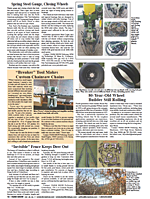You have reached your limit of 3 free stories. A story preview is shown instead.
To view more stories
(If your subscription is current,
click here to Login or Register.)
Siberian Peach Trees Survive Bitter Cold
USDA researchers introduced the Siberian peach tree for use as rootstock, but a southwest Wisconsin fruit and nut tree breeder has developed it for its fruit. mIEKAL aND (preferred spelling) has been working with the variety for more than 20 years. Initially, selection was accidental.
“I had purchased a bunch of
..........
You must sign in, subscribe or renew to see the page.

You must sign in, subscribe or renew to see the flip-book
Siberian Peach Trees Survive Bitter Cold
USDA researchers introduced the Siberian peach tree for use as rootstock, but a southwest Wisconsin fruit and nut tree breeder has developed it for its fruit. mIEKAL aND (preferred spelling) has been working with the variety for more than 20 years. Initially, selection was accidental.
“I had purchased a bunch of stuff from a nursery that specialized in permaculture in 1992, including some Siberians advertised as rootstock for grafting,” recalls aND. “I never grafted them, and in a couple of years, several had produced fruit. Only half of them were pickable, and the rest were tiny and mealy.”
He planted the pits, and when they fruited, found some with flavor. Their pits were planted in turn, and as they bore fruit, he continued to select for flavor. The selection process was jump-started when some displayed rapid growth and maturity.
“I had some that were precocious and reached 15 ft. in height and flowered in only three years,” says aND. “I kept selecting from the best and growing them out.”
The cold tolerance of up to -45 F promised by the USDA proved out when aND’s orchard was hit with a polar vortex, not once but twice. The Siberians survived. He had previously planted Iowa Indian White, also touted for its cold tolerance.
“The Iowa Indian White died back to the ground, but none of the Siberians did,” says aND.
His select Siberians are now in their sixth generation.
“They’re small, only about 1 1/2-in. in diameter, but delicious.”
While he continues to seek improved selections, he’s also begun to commercialize them. He sells seedlings at a local farmers market. Learning of his success with the Siberians, a couple of nurseries purchased pits to germinate and grow out a few years ago. Since then, other fruit tree breeders have begun ordering pits. They are priced at 10 pits for $15 or 100 for $100.
What aND doesn’t do is sell the peaches whole. He’s a long-time maker of wines, meads and vinegars. Most are sold at his local farmers market, where he also sells more than 20 different cold-hardy cultivar seedlings, salsas and more.
“I juice the peaches, so I can keep the pits for replanting,” he says. In 2024, he introduced a peach nectar, and he also sells peach vinegar.
“The peach nectar sold out every week,” says aND. “The Siberian has a stronger peach flavor than other white peaches. It’s not just sweet, but has a little zing to it. It makes a really good nectar, and with its low pH, it can be sold as fresh juice at the farmers market.”
Cold-weather peaches aren’t the only trees aND is working with. Others include pawpaws, pecans and Perry Pears, used for making pear cider.
His Perry Pears are attracting attention with several nurseries now selling them.
He also sells cuttings for figs, elderberries, currants, grapes, kiwis, goji, and 16 varieties of willow. Scion wood is available for mulberry, crabapple and pears.
A listing of available cuttings, scion wood and seeds, along with pricing, can be found on his website.
Contact: FARM SHOW Followup, Nursery & Forest Gardens, Dreamtime Village, 10375 County Hwy A, West Lima, Wis. 54639 (ph 608-625-4619; people@dreamtimevillage.org; www.beyondvineyard.com; www.facebook.com/beyondvineyard; www.facebook.com/driftlessgrove).
To read the rest of this story, download this issue below or click
here to register with your account number.





